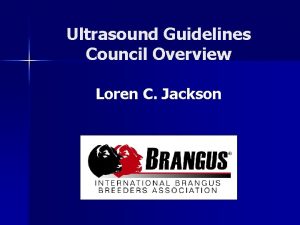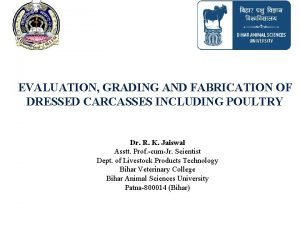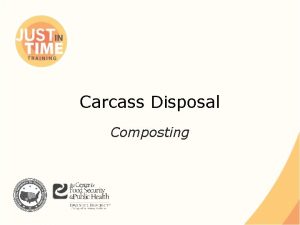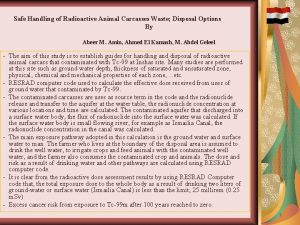Carcass disposal Introduction Proper disposal of carcasses is




- Slides: 4

Carcass disposal Introduction Proper disposal of carcasses is of utmost importance in preventing the spread of diseases, and as in case of anthrax, to prevent human infection. Carcasses should never be disposed off by depositing them in or near a stream of flowing water, because this will carry infections to points downstream. An animal died of a infectious disease should not be allowed to remain longer in sheds as biting insects, rodents, etc. can reach it. Unless approved by a veterinarian ( even then, only in a disinfected place) it is not safe to open carcasses of animals that have died of a disease. All carcasses should be disposed off properly either by burying or by burning.

Burial of carcasses Deep burial is necessary to prevent worms carrying bacterial spores to the surface as well as to prevent carnivorous animals from digging up the carcass. The pit should be so dug that the highest part of the carcass must be at least 1. 5 m below the level of the surrounding terrain, the width and length of the burial pit depending on the size of the carcass. Bedding used for the dead animals, its excreta, feed left over by it and the top 5 cm soil from where the dead animals was lying (if the floor is not cemented) should also be buried along with the carcass. After the carcass is in the grave its skin should be slashed to discourage grave-diggers to exhume the carcass later for its skin. Then, in order to make it unpalatable to marauding animals, it may be drenched with kerosene, crude phenol or a comparable odorous and bad tasting substance. The carcass is then covered with a thick layer of freshly burnt quicklime and then filled with dirt and topped with some rocks, to further circumvent marauders.

Burning of carcasses The most sanitary method of destroying carcasses. The trench should be at least 0. 5 m deep, shallower towards the ends, and comparing in width and length to the carcass’s size. General direction of the trench should be that of the prevailing wing direction. The trench is first filled with wood, some iron bars placed across it and the carcass placed thereon. By firing the wood, the carcass will be completely consumed and, with it, all infectious material. In towns and cities the so-called carcass utilization or carcass frying or rendering plants are usually available for industrial utilization of animal’s carcasses. In these the skins are removed with due regard for the dangers of disease dissemination. After removal, the skins are usually disinfected by immersion in a disinfecting solution and the remainder of the carcass ‘fried out’ for its fat, the latter being used in manufacture of soap. Farmers can inform these plants whenever there is a carcass so that these utilization plants can collect the same.

Interference with the causal pathogen or with the course of disease can be used as complementary to the other methods in combating disease outbreaks on animal farms. Interference includes such procedures as disinfection and disinfestation, treatment of sick animals and measures aimed at the elimination of carrier animals and intermediate hosts, if any. There a number of problems in the practical implementation of such disease control procedures, especially in this country, where illiterate and ignorant villagers under questionable conditions of hygiene and sanitation mostly keep animals.







